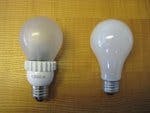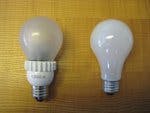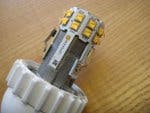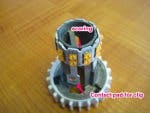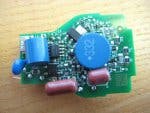Appearance is important for an LED bulb: For example, the Philips L Prize bulb’s unconventional secondary phosphor yellow-when-off bulb is a drawback for some and a plus for others. The Cree bulb has a similar shape to an incandescent bulb Fig. 1 and, while a little heavier, is still quite light: 4 oz. for the Cree vs. 1 oz. for an incandescent.
I removed the silicone-coated glass bulb cover and found it was still possible to operate the light and probe for some voltages. Fig. 2. At full power, the voltage across the LEDs was 220Vdc; When dimmed to where the light cut out it was 207Vdc.
The 80 LEDs (4 LEDs per individual LED component; 20 individual LED components) are arranged in an array of two parallel strings each with 10 individual LED components, making 40 LEDs per string. I asked Mike Watson, Cree’s VP of corporate marketing, about the long series strings of LEDs: One LED failing open would take out an entire LED string, causing half the bulb to go dark. He said the PPM (parts/million) failure for an LED in the field – especially one that would fail open -- is almost vanishingly low, which gives Cree the confidence to warranty these bulbs for 10 years.
Fig. 4 shows the plastic guide that runs up the center of the metallic column, carrying power from the driver on the pc board up through the column and then through the clips around to the outer surface of the column.
There was no isolation transformer, indicating that the design was non-isolated (which continues the trend seen in the Best Buy Insignia bulb.) Non-isolated LED drivers drop the parts count significantly and shrink the space needed for power management, dimming, and power factor correction (PFC). As you can see from the photos of the bulb’s single small pc board Figs. 5 and 6, this bulb has amazingly few components. It also has excellent PFC – I measured .98 PF with a Kill-o-Watt meter.
The most common way for LED bulbs to handle dimming signals from triac switches is to decode the power from the triac through a high-frequency pulse-width modulation circuit. Says Watson: “We don’t use that approach in this particular bulb. We have a very proprietary type of RMS process that involves our IP (intellectual property) and phase dimming.” Cree’s reticence is understandable: Why make it easy for your competition to copy you?
The bulb’s only power management IC is the STMicroelectronics 6561D transition mode power factor corrector. The ST website has app note AN2711 (a pdf) 120Vac input Triac dimmable LED driver for the L6562A, a chip in the same family as the 6561, that explains the use of the 656X Chip to handle triac dimming as well as PFC in a flyback power converter topology. Granted, it’s for an isolated LED driver, but its detailed explanation of using the chip for dimming is still valid as an insight into how the Cree driver may work.
This bulb is my new favorite LED bulb, and at under $13 it’s a great value. Is there room for another price drop? Most likely: Ed Crawford, CEO of Cree’s competitor Philips Lighting, says Philips will have an under-$10 LED by the end of this year.
For an extended version of the Cree bulb tear down and review, visit:
Cree 60W LED replacement bulb review and tear down
Q&A with Cree about 60W-replacement LED bulb
Cree 60W bulb by the numbers:
Cree is offering both a 40W and 60W version of the light; My review here covers just the 60W 2700K version.
- The specs:
- Dimmable
- 800 lumens
- Light appearance: 2700K
- Warranty: 10 years
- Power: 9.5W: 120Vac, 79mA
- PF (measured): .98
- Sold at Home Depot
- $12.97 ea; or six-pack for $74.82 ($12.47 ea.)
- Cree also makes a 40W-replacement, 2700K version that costs $9.97 and uses 6W, and a 60W-replacement, 5000K version that costs $13.97 and uses 9W.
